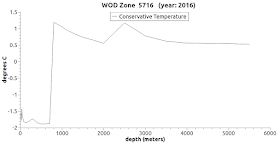 |
| Antarctic Zone 5716 |
| Arctic Zone 7716 |
I mentioned that the Dredd Blog SQL server had been updated with the latest WOD data (ibid).
 |
| Antarctic Zone 5716 |
 |
| Arctic Zone 7716 |
 |
| Antarctic Zone 5716 |
 |
| Arctic Zone 7716 |
Here at Dredd Blog, as I have mentioned from time to time, we use the CTD (conductivity, temperature, depth) and PFL (profile) datasets contained in the WOD database.
I have about 1.3 billion measurements from the CTD and PFL datasets which I use to contemplate the nature of the world oceans.
Today, let's look at two areas of the world ocean located at opposite polar regions (Arctic and Antarctic) to see if our gut feelings can explain their nature robustly.
One might think that since the polar regions of the globe are cold regions which have land masses covered with ice sheets, which have ocean expanses covered with sea ice, and also have glaciers and icebergs, then they are essentially identical in nature.
No doubt there are similarities, but that has led us astray in the past, because the differences in their natures were not obvious.
So, to peer down into the depths of the Antarctic and Arctic ocean waters, I generated some graphs that show some of the contrasting nature of the ocean waters in those areas.
The Arctic graphs are concerned with WOD Zone 7716, while the Antarctic graphs are concerned with WOD Zone 5716.
In today's post there are three sections with two graphs in each section.
The top section concerns Conservative Temperature at all depths which have measurements recorded in the WOD database for that zone.
The middle section concerns Absolute Salinity at all depths which have measurements recorded in the WOD database for that zone.
The bottom section concerns Thermal Expansion / Contraction at all depths which have measurements recorded in the WOD database for that zone.
All of these values are calculated from in situ measurements using the TEOS-10 software library.
The in situ measurements used to generate all graphs in all three sections were measurements taken in the year 2016.
 |
| Idealized depth/temperatures |
The top graph in each section concerns the Antarctic, while the lower graph in each section concerns the Arctic.
On to the differences.
In the first and second graphs in the first section of today's post, the Conservative Temperature of the seawater is depicted at depths of 10 meters down to 5,000 meters.
Notice that the Antarctic (Zone 5716) surface water is colder than the waters from about 1,000 meters on down, indicating that fresh melt-water is at the surface.
The Antarctic graph in the second section confirms that indication, showing that Absolute Salinity is less at the surface than it is from 1,000 meters on down (generally, fresher and lighter melt-water floats on top of the heavier salty seawater).
The Arctic seawater Conservative Temperature does not follow the Antarctic pattern, but the Absolute Salinity pattern is fairly close to it.
The Antarctic and Arctic Thermal Expansion / Contraction graphs in the third section are pretty much opposite to one another.
The "idealized" temperature at depth graphic (last graphic above) seems out of place eh?
I am working on software that will present a report of this type, but not in graph format, for all the WOD zones.
I will report on the results in future posts.
The next post in this series is here, the previous post in this series is here.
No comments:
Post a Comment